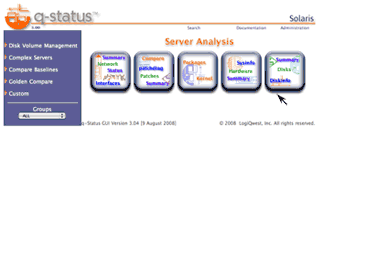| Step |
Action |
Description |
| 1 |
Use zoneadm list on the global zone server to show status of zone |
| # /usr/sbin/zoneadm list -vi |
On the global zone, use the zoneadm list -vi to show current status of all installed zones.
global# /usr/sbin/zoneadm list -vi
ID NAME STATUS PATH BRAND IP
0 global running / native shared
2 lqwdev running /zones/lqwdev native shared
5 lqweb running /zones/lqweb native shared
- myzone installed /zones/myzone native shared
- myzone2 installed /zones/myzone2 native shared
- myzone3 installed /zones/myzone3< native shared
global#
|
On the global zone, use the zoneadm list -vc to show current status of all configured zones.
global# /usr/sbin/zoneadm list -vc
ID NAME STATUS PATH BRAND IP
0 global running / native shared
2 rlogic running /zones/rlogic native shared
3 utility running /zones/utility native shared
4 myzone running /zones/myzone native shared
- junkzone incomplete /zones/junkzone native shared
global#
|
| Note: |
You may also use /usr/sbin/zoneadm -z <zone name> list -v to verify the specific zone status. |
|
| 2 |
Use zoneadm -z with the boot option to start an instlled zone. |
| # zoneadm -z <zone name> boot |
On the global zone, Boot the new zone by issuing zoneadm -z <zonename> boot.
global# /usr/sbin/zoneadm list -vi
ID NAME STATUS PATH BRAND IP
0 global running / native shared
2 lqwdev running /zones/lqwdev native shared
5 lqweb running /zones/lqweb native shared
- myzone installed /zones/myzone native shared
- myzone2 installed /zones/myzone2 native shared
- myzone3 installed /zones/myzone3 native shared
global# zoneadm -z myzone boot
|
|
| 3 |
Use zoneadm list on the global zone server to show status of zone |
| # /usr/sbin/zoneadm list -vi |
On the global zone, use the zoneadm list -vi to verify that the zone is now running.
global# /usr/sbin/zoneadm list -vi
ID NAME STATUS PATH BRAND IP
0 global running / native shared
2 lqwdev running /zones/lqwdev native shared
5 lqweb running /zones/lqweb native shared
- myzone installed /zones/myzone native shared
- myzone2 installed /zones/myzone2 native shared
- myzone3 installed /zones/myzone3 native shared
global# zoneadm -z myzone boot
global# /usr/sbin/zoneadm list -vi
ID NAME STATUS PATH BRAND IP
0 global running / native shared
2 lqwdev running /zones/lqwdev native shared
5 lqweb running /zones/lqweb native shared
7 myzone running /zones/myzone native shared
- myzone2 installed /zones/myzone2 native shared
- myzone3 installed /zones/myzone3 native shared
global#
|
| Note: |
You may also use /usr/sbin/zoneadm -z <zone name> list -v to verify the specific zone status. |
|
